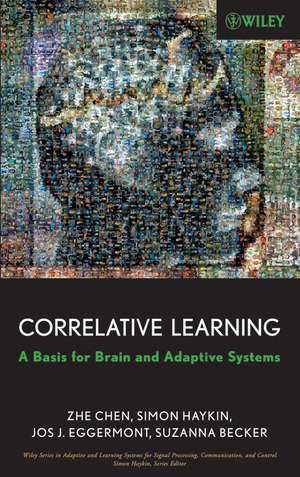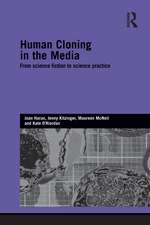Correlative Learning – A Basis for Brain and Adaptive Systems: Adaptive and Cognitive Dynamic Systems: Signal Processing, Learning, Communications and Control
Autor Z Chenen Limba Engleză Hardback – 5 noi 2007
Din seria Adaptive and Cognitive Dynamic Systems: Signal Processing, Learning, Communications and Control
- 9%
 Preț: 1001.74 lei
Preț: 1001.74 lei - 9%
 Preț: 1003.18 lei
Preț: 1003.18 lei - 9%
 Preț: 1103.68 lei
Preț: 1103.68 lei - 9%
 Preț: 1402.86 lei
Preț: 1402.86 lei - 9%
 Preț: 1158.92 lei
Preț: 1158.92 lei - 5%
 Preț: 1215.26 lei
Preț: 1215.26 lei - 9%
 Preț: 1503.44 lei
Preț: 1503.44 lei - 9%
 Preț: 1307.34 lei
Preț: 1307.34 lei - 9%
 Preț: 1198.12 lei
Preț: 1198.12 lei - 9%
 Preț: 811.69 lei
Preț: 811.69 lei - 9%
 Preț: 1145.12 lei
Preț: 1145.12 lei - 9%
 Preț: 1015.63 lei
Preț: 1015.63 lei - 9%
 Preț: 1123.13 lei
Preț: 1123.13 lei - 9%
 Preț: 1159.85 lei
Preț: 1159.85 lei - 9%
 Preț: 1340.54 lei
Preț: 1340.54 lei - 9%
 Preț: 1224.07 lei
Preț: 1224.07 lei - 9%
 Preț: 1011.17 lei
Preț: 1011.17 lei - 9%
 Preț: 1216.19 lei
Preț: 1216.19 lei - 9%
 Preț: 967.23 lei
Preț: 967.23 lei - 9%
 Preț: 1487.44 lei
Preț: 1487.44 lei - 9%
 Preț: 769.44 lei
Preț: 769.44 lei - 9%
 Preț: 810.68 lei
Preț: 810.68 lei - 9%
 Preț: 866.54 lei
Preț: 866.54 lei - 9%
 Preț: 758.12 lei
Preț: 758.12 lei - 32%
 Preț: 770.96 lei
Preț: 770.96 lei - 32%
 Preț: 631.00 lei
Preț: 631.00 lei - 33%
 Preț: 796.18 lei
Preț: 796.18 lei - 32%
 Preț: 597.31 lei
Preț: 597.31 lei - 31%
 Preț: 646.36 lei
Preț: 646.36 lei
Preț: 1121.12 lei
Preț vechi: 1232.00 lei
-9% Nou
Puncte Express: 1682
Preț estimativ în valută:
214.56€ • 223.17$ • 177.13£
214.56€ • 223.17$ • 177.13£
Carte tipărită la comandă
Livrare economică 14-28 aprilie
Preluare comenzi: 021 569.72.76
Specificații
ISBN-13: 9780470044889
ISBN-10: 0470044888
Pagini: 480
Dimensiuni: 166 x 238 x 29 mm
Greutate: 0.82 kg
Editura: Wiley
Seria Adaptive and Cognitive Dynamic Systems: Signal Processing, Learning, Communications and Control
Locul publicării:Hoboken, United States
ISBN-10: 0470044888
Pagini: 480
Dimensiuni: 166 x 238 x 29 mm
Greutate: 0.82 kg
Editura: Wiley
Seria Adaptive and Cognitive Dynamic Systems: Signal Processing, Learning, Communications and Control
Locul publicării:Hoboken, United States
Public țintă
The intended readership of this book will range from advanced undergraduate to graduate students and nonspecialist researchers in a wide range of disciplines including neuroscientists, signal–processing researchers, computer scientists and people who have a general interest in understanding the brain as well as building adaptive learning systems.Descriere
This book bridges the communication gap between neuroscientists and engineers through the unifying theme of correlation–based learning
Developing brain–style signal processing or machine learning algorithms has attracted many sharp minds from a range of disciplines. Now, coauthored by four researchers with varying backgrounds in signal processing, neuroscience, psychology, and computer science, Correlative Learning unifies the many cross–fertilized ideas in computational neuroscience and signal processing in a common language that will help engineers understand and appreciate the human brain as a highly sophisticated biosystem for building more intelligent machines.
First, the authors present the necessary neuroscience background for engineers, and then go on to relate the common intrinsic structures of the learning mechanisms of the brain to signal processing, machine learning, kernel learning, complex–valued domains, and the ALOPEX learning paradigm.
This correlation–based approach to building complex, reliable (robust), and adaptive systems is vital for engineers, researchers, and graduate students from various fields of science and engineering. Figures, tables, worked examples, and case studies illustrate how to use computational tools for either helping to understand brain functions or fitting specific engineering applications, and a comprehensive bibliography covering over 1,000 references from major publications is included for further reading.
Developing brain–style signal processing or machine learning algorithms has attracted many sharp minds from a range of disciplines. Now, coauthored by four researchers with varying backgrounds in signal processing, neuroscience, psychology, and computer science, Correlative Learning unifies the many cross–fertilized ideas in computational neuroscience and signal processing in a common language that will help engineers understand and appreciate the human brain as a highly sophisticated biosystem for building more intelligent machines.
First, the authors present the necessary neuroscience background for engineers, and then go on to relate the common intrinsic structures of the learning mechanisms of the brain to signal processing, machine learning, kernel learning, complex–valued domains, and the ALOPEX learning paradigm.
This correlation–based approach to building complex, reliable (robust), and adaptive systems is vital for engineers, researchers, and graduate students from various fields of science and engineering. Figures, tables, worked examples, and case studies illustrate how to use computational tools for either helping to understand brain functions or fitting specific engineering applications, and a comprehensive bibliography covering over 1,000 references from major publications is included for further reading.
Textul de pe ultima copertă
This book bridges the communication gap between neuroscientists and engineers through the unifying theme of correlation–based learning
Developing brain–style signal processing or machine learning algorithms has attracted many sharp minds from a range of disciplines. Now, coauthored by four researchers with varying backgrounds in signal processing, neuroscience, psychology, and computer science, Correlative Learning unifies the many cross–fertilized ideas in computational neuroscience and signal processing in a common language that will help engineers understand and appreciate the human brain as a highly sophisticated biosystem for building more intelligent machines.
First, the authors present the necessary neuroscience background for engineers, and then go on to relate the common intrinsic structures of the learning mechanisms of the brain to signal processing, machine learning, kernel learning, complex–valued domains, and the ALOPEX learning paradigm.
This correlation–based approach to building complex, reliable (robust), and adaptive systems is vital for engineers, researchers, and graduate students from various fields of science and engineering. Figures, tables, worked examples, and case studies illustrate how to use computational tools for either helping to understand brain functions or fitting specific engineering applications, and a comprehensive bibliography covering over 1,000 references from major publications is included for further reading.
Developing brain–style signal processing or machine learning algorithms has attracted many sharp minds from a range of disciplines. Now, coauthored by four researchers with varying backgrounds in signal processing, neuroscience, psychology, and computer science, Correlative Learning unifies the many cross–fertilized ideas in computational neuroscience and signal processing in a common language that will help engineers understand and appreciate the human brain as a highly sophisticated biosystem for building more intelligent machines.
First, the authors present the necessary neuroscience background for engineers, and then go on to relate the common intrinsic structures of the learning mechanisms of the brain to signal processing, machine learning, kernel learning, complex–valued domains, and the ALOPEX learning paradigm.
This correlation–based approach to building complex, reliable (robust), and adaptive systems is vital for engineers, researchers, and graduate students from various fields of science and engineering. Figures, tables, worked examples, and case studies illustrate how to use computational tools for either helping to understand brain functions or fitting specific engineering applications, and a comprehensive bibliography covering over 1,000 references from major publications is included for further reading.
Cuprins
Foreword. Preface.
Acknowledgments.
Acronyms.
Introduction.
1. The Correlative Brain.
1.1 Background.
1.1.1 Spiking Neurons.
1.1.2 Neocortex.
1.1.3 Receptive fields.
1.1.4 Thalamus.
1.1.5 Hippocampus.
1.2 Correlation Detection in Single Neurons.
1.3 Correlation in Ensembles of Neurons: Synchrony and Population Coding.
1.4 Correlation is the Basis of Novelty Detection and Learning.
1.5 Correlation in Sensory Systems: Coding, Perception, and Development.
1.6 Correlation in Memory Systems.
1.7 Correlation in Sensory–Motor Learning.
1.8 Correlation, Feature Binding, and Attention.
1.9 Correlation and Cortical Map Changes after Peripheral Lesions and Brain Stimulation.
1.10 Discussion.
2. Correlation in Signal Processing.
2.1 Correlation and Spectrum Analysis.
2.1.1 Stationary Process.
2.1.2 Non–stationary Process.
2.1.3 Locally Stationary Process.
2.1.4 Cyclostationary Process.
2.1.5 Hilbert Spectrum Analysis.
2.1.6 Higher Order Correlation–based Bispectra Analysis.
2.1.7 Higher Order Functions of Time, Frequency, Lag, and Doppler.
2.1.8 Spectrum Analysis of Random Point Process.
2.2 Wiener Filter.
2.3 Least–Mean–Square Filter.
2.4 Recursive Least–Squares Filter.
2.5 Matched Filter.
2.6 Higher Order Correlation–Based Filtering.
2.7 Correlation Detector.
2.7.1 Coherent Detection.
2.7.2 Correlation Filter for Spatial Target Detection.
2.8 Correlation Method for Time–Delay Estimation.
2.9 Correlation–Based Statistical Analysis.
2.9.1 Principal Component Analysis.
2.9.2 Factor Analysis.
2.9.3 Canonical Correlation Analysis.
2.9.4 Fisher Linear Discriminant Analysis.
2.9.5 Common Spatial Pattern Analysis.
2.10 Discussion.
Appendix: Eigenanalysis of Autocorrelation Function of Nonstationary Process.
Appendix: Estimation of the Intensity and Correlation Functions of Stationary Random Point Process.
Appendix: Derivation of Learning Rules with Quasi–Newton Method.
3. Correlation–Based Neural Learning and Machine Learning.
3.1 Correlation as a Mathematical Basis for Learning.
3.1.1 Hebbian and Anti–Hebbian Rules (Revisited).
3.1.2 Covariance Rule.
3.1.3 Grossberg s Gated Steepest Descent.
3.1.4 Competitive Learning Rule.
3.1.5 BCM Learning Rule.
3.1.6 Local PCA Learning Rule.
3.1.7 Generalizations of PCA Learning.
3.1.8 CCA Learning Rule.
3.1.9 Wake–Sleep Learning Rule for Factor Analysis.
3.1.10 Boltzmann Learning Rule.
3.1.11 Perceptron Rule and Error–Correcting Learning Rule.
3.1.12 Differential Hebbian Rule and Temporal Hebbian Learning.
3.1.13 Temporal Difference and Reinforcement Learning.
3.1.14 General Correlative Learning and Potential Function.
3.2 Information–Theoretic Learning.
3.2.1 Mutual Information vs. Correlation.
3.2.2 Barlow s Postulate.
3.2.3 Hebbian Learning and Maximum Entropy.
3.2.4 Imax Algorithm.
3.2.5 Local Decorrelative Learning.
3.2.6 Blind Source Separation.
3.2.7 Independent Component Analysis.
3.2.8 Slow Feature Analysis.
3.2.9 Energy–Efficient Hebbian Learning.
3.2.10 Discussion.
3.3 Correlation–Based Computational Neural Models.
3.3.1 Correlation Matrix Memory.
3.3.2 Hopfield Network.
3.3.3 Brain–State–in–a–Box Model.
3.3.4 Autoencoder Network.
3.3.5 Novelty Filter.
3.3.6 Neuronal Synchrony and Binding.
3.3.7 Oscillatory Correlation.
3.3.8 Modeling Auditory Functions.
3.3.9 Correlations in the Olfactory System.
3.3.10 Correlations in the Visual System.
3.3.11 Elastic Net.
3.3.12 CMAC and Motor Learning.
3.3.13 Summarizing Remarks.
Appendix: Mathematical Analysis of Hebbian Learning.
Appendix: Necessity and Convergence of Anti–Hebbian Learning.
Appendix: Link Between the Hebbian Rule and Gradient Descent.
Appendix: Reconstruction Error in Linear and Quadratic PCA.
4. Correlation–Based Kernel Learning.
4.1 Background.
4.2 Kernel PCA and Kernelized GHA.
4.3 Kernel CCA and Kernel ICA.
4.4 Kernel Principal Angles.
4.5 Kernel Discriminant Analysis.
4.6 KernelWiener Filter.
4.7 Kernel–Based Correlation Analysis: Generalized Correlation Function and Correntropy.
4.8 Kernel Matched Filter.
4.9 Discussion.
5. Correlative Learning in a Complex–Valued Domain.
5.1 Preliminaries.
5.2 Complex–Valued Extensions of Correlation–Based Learning.
5.2.1 Complex–Valued Associative Memory.
5.2.2 Complex–Valued Boltzmann Machine.
5.2.3 Complex–Valued LMS Rule.
5.2.4 Complex–Valued PCA Learning.
5.2.5 Complex–Valued ICA Learning.
5.2.6 Constant Modulus Algorithm.
5.3 Kernel Methods for Complex–Valued Data.
5.3.1 Reproducing Kernels in the Complex Domain.
5.3.2 Complex–Valued Kernel PCA.
5.4 Discussion.
6. ALOPEX: A Correlation–Based Learning Paradigm.
6.1 Background.
6.2 The Basic ALOPEX Rule.
6.3 Variants of the ALOPEX Algorithm.
6.3.1 Unnikrishnan and Venugopal s ALOPEX.
6.3.2 Bia s ALOPEX–B.
6.3.3 An Improved Version of the ALOPEX–B.
6.3.4 Two–Timescale ALOPEX.
6.3.5 Other Types of Correlation Mechanisms.
6.4 Discussion.
6.5 Monte Carlo Sampling–Based ALOPEX Algorithms.
6.5.1 Sequential Monte Carlo Estimation.
6.5.2 Sampling–Based ALOPEX Algorithms.
6.5.3 Remarks.
Appendix: Asymptotical Analysis of the ALOPEX Process.
Appendix: Asymptotic Convergence Analysis of the 2t–ALOPEX Algorithm.
7. Case Studies.
7.1 Hebbian Competition as the Basis for Cortical Map Reorganization?
7.2 Learning Neurocompensator: A Model–Based Hearing Compensation Strategy.
7.2.1 Background.
7.2.2 Model–Based Hearing Compensation Strategy.
7.2.3 Optimization.
7.2.4 Experimental Results.
7.2.5 Summary.
7.3 Online Training of Artificial Neural Networks.
7.3.1 Background.
7.3.2 Parameters Setup.
7.3.3 Online Option Prices Prediction.
7.3.4 Online System Identification.
7.3.5 Summary.
7.4 Kalman Filtering in Computational Neural Modeling.
7.4.1 Background.
7.4.2 Overview of Kalman Filter in Modeling Brain Functions.
7.4.3 Kalman Filter for Learning Shape and Motion from Image Sequences.
7.4.4 General Remarks and Implications.
8. Discussion.
8.1 Summary: Why Correlation?
8.1.1 Hebbian Plasticity and the Correlative Brain.
8.1.2 Correlation–Based Signal Processing.
8.1.3 Correlation–Based Machine Learning.
8.2 Epilogue: What Next?
8.2.1 Generalizing the Correlation Measure.
8.2.2 Deciphering the Correlative Brain.
Appendix A: Autocorrelation and Cross–correlation Functions.
Appendix B: Stochastic Approximation.
Appendix C: A Primer on Linear Algebra.
Appendix D: Probability Density and Entropy Estimators.
Appendix E: EM Algorithm.
Topic Index.
Acknowledgments.
Acronyms.
Introduction.
1. The Correlative Brain.
1.1 Background.
1.1.1 Spiking Neurons.
1.1.2 Neocortex.
1.1.3 Receptive fields.
1.1.4 Thalamus.
1.1.5 Hippocampus.
1.2 Correlation Detection in Single Neurons.
1.3 Correlation in Ensembles of Neurons: Synchrony and Population Coding.
1.4 Correlation is the Basis of Novelty Detection and Learning.
1.5 Correlation in Sensory Systems: Coding, Perception, and Development.
1.6 Correlation in Memory Systems.
1.7 Correlation in Sensory–Motor Learning.
1.8 Correlation, Feature Binding, and Attention.
1.9 Correlation and Cortical Map Changes after Peripheral Lesions and Brain Stimulation.
1.10 Discussion.
2. Correlation in Signal Processing.
2.1 Correlation and Spectrum Analysis.
2.1.1 Stationary Process.
2.1.2 Non–stationary Process.
2.1.3 Locally Stationary Process.
2.1.4 Cyclostationary Process.
2.1.5 Hilbert Spectrum Analysis.
2.1.6 Higher Order Correlation–based Bispectra Analysis.
2.1.7 Higher Order Functions of Time, Frequency, Lag, and Doppler.
2.1.8 Spectrum Analysis of Random Point Process.
2.2 Wiener Filter.
2.3 Least–Mean–Square Filter.
2.4 Recursive Least–Squares Filter.
2.5 Matched Filter.
2.6 Higher Order Correlation–Based Filtering.
2.7 Correlation Detector.
2.7.1 Coherent Detection.
2.7.2 Correlation Filter for Spatial Target Detection.
2.8 Correlation Method for Time–Delay Estimation.
2.9 Correlation–Based Statistical Analysis.
2.9.1 Principal Component Analysis.
2.9.2 Factor Analysis.
2.9.3 Canonical Correlation Analysis.
2.9.4 Fisher Linear Discriminant Analysis.
2.9.5 Common Spatial Pattern Analysis.
2.10 Discussion.
Appendix: Eigenanalysis of Autocorrelation Function of Nonstationary Process.
Appendix: Estimation of the Intensity and Correlation Functions of Stationary Random Point Process.
Appendix: Derivation of Learning Rules with Quasi–Newton Method.
3. Correlation–Based Neural Learning and Machine Learning.
3.1 Correlation as a Mathematical Basis for Learning.
3.1.1 Hebbian and Anti–Hebbian Rules (Revisited).
3.1.2 Covariance Rule.
3.1.3 Grossberg s Gated Steepest Descent.
3.1.4 Competitive Learning Rule.
3.1.5 BCM Learning Rule.
3.1.6 Local PCA Learning Rule.
3.1.7 Generalizations of PCA Learning.
3.1.8 CCA Learning Rule.
3.1.9 Wake–Sleep Learning Rule for Factor Analysis.
3.1.10 Boltzmann Learning Rule.
3.1.11 Perceptron Rule and Error–Correcting Learning Rule.
3.1.12 Differential Hebbian Rule and Temporal Hebbian Learning.
3.1.13 Temporal Difference and Reinforcement Learning.
3.1.14 General Correlative Learning and Potential Function.
3.2 Information–Theoretic Learning.
3.2.1 Mutual Information vs. Correlation.
3.2.2 Barlow s Postulate.
3.2.3 Hebbian Learning and Maximum Entropy.
3.2.4 Imax Algorithm.
3.2.5 Local Decorrelative Learning.
3.2.6 Blind Source Separation.
3.2.7 Independent Component Analysis.
3.2.8 Slow Feature Analysis.
3.2.9 Energy–Efficient Hebbian Learning.
3.2.10 Discussion.
3.3 Correlation–Based Computational Neural Models.
3.3.1 Correlation Matrix Memory.
3.3.2 Hopfield Network.
3.3.3 Brain–State–in–a–Box Model.
3.3.4 Autoencoder Network.
3.3.5 Novelty Filter.
3.3.6 Neuronal Synchrony and Binding.
3.3.7 Oscillatory Correlation.
3.3.8 Modeling Auditory Functions.
3.3.9 Correlations in the Olfactory System.
3.3.10 Correlations in the Visual System.
3.3.11 Elastic Net.
3.3.12 CMAC and Motor Learning.
3.3.13 Summarizing Remarks.
Appendix: Mathematical Analysis of Hebbian Learning.
Appendix: Necessity and Convergence of Anti–Hebbian Learning.
Appendix: Link Between the Hebbian Rule and Gradient Descent.
Appendix: Reconstruction Error in Linear and Quadratic PCA.
4. Correlation–Based Kernel Learning.
4.1 Background.
4.2 Kernel PCA and Kernelized GHA.
4.3 Kernel CCA and Kernel ICA.
4.4 Kernel Principal Angles.
4.5 Kernel Discriminant Analysis.
4.6 KernelWiener Filter.
4.7 Kernel–Based Correlation Analysis: Generalized Correlation Function and Correntropy.
4.8 Kernel Matched Filter.
4.9 Discussion.
5. Correlative Learning in a Complex–Valued Domain.
5.1 Preliminaries.
5.2 Complex–Valued Extensions of Correlation–Based Learning.
5.2.1 Complex–Valued Associative Memory.
5.2.2 Complex–Valued Boltzmann Machine.
5.2.3 Complex–Valued LMS Rule.
5.2.4 Complex–Valued PCA Learning.
5.2.5 Complex–Valued ICA Learning.
5.2.6 Constant Modulus Algorithm.
5.3 Kernel Methods for Complex–Valued Data.
5.3.1 Reproducing Kernels in the Complex Domain.
5.3.2 Complex–Valued Kernel PCA.
5.4 Discussion.
6. ALOPEX: A Correlation–Based Learning Paradigm.
6.1 Background.
6.2 The Basic ALOPEX Rule.
6.3 Variants of the ALOPEX Algorithm.
6.3.1 Unnikrishnan and Venugopal s ALOPEX.
6.3.2 Bia s ALOPEX–B.
6.3.3 An Improved Version of the ALOPEX–B.
6.3.4 Two–Timescale ALOPEX.
6.3.5 Other Types of Correlation Mechanisms.
6.4 Discussion.
6.5 Monte Carlo Sampling–Based ALOPEX Algorithms.
6.5.1 Sequential Monte Carlo Estimation.
6.5.2 Sampling–Based ALOPEX Algorithms.
6.5.3 Remarks.
Appendix: Asymptotical Analysis of the ALOPEX Process.
Appendix: Asymptotic Convergence Analysis of the 2t–ALOPEX Algorithm.
7. Case Studies.
7.1 Hebbian Competition as the Basis for Cortical Map Reorganization?
7.2 Learning Neurocompensator: A Model–Based Hearing Compensation Strategy.
7.2.1 Background.
7.2.2 Model–Based Hearing Compensation Strategy.
7.2.3 Optimization.
7.2.4 Experimental Results.
7.2.5 Summary.
7.3 Online Training of Artificial Neural Networks.
7.3.1 Background.
7.3.2 Parameters Setup.
7.3.3 Online Option Prices Prediction.
7.3.4 Online System Identification.
7.3.5 Summary.
7.4 Kalman Filtering in Computational Neural Modeling.
7.4.1 Background.
7.4.2 Overview of Kalman Filter in Modeling Brain Functions.
7.4.3 Kalman Filter for Learning Shape and Motion from Image Sequences.
7.4.4 General Remarks and Implications.
8. Discussion.
8.1 Summary: Why Correlation?
8.1.1 Hebbian Plasticity and the Correlative Brain.
8.1.2 Correlation–Based Signal Processing.
8.1.3 Correlation–Based Machine Learning.
8.2 Epilogue: What Next?
8.2.1 Generalizing the Correlation Measure.
8.2.2 Deciphering the Correlative Brain.
Appendix A: Autocorrelation and Cross–correlation Functions.
Appendix B: Stochastic Approximation.
Appendix C: A Primer on Linear Algebra.
Appendix D: Probability Density and Entropy Estimators.
Appendix E: EM Algorithm.
Topic Index.
Notă biografică
Zhe Chen, PhD, is currently a Research Fellow in the Neuroscience Statistics Research Laboratory at Harvard Medical School.
Simon Haykin, PhD, DSc, is a Distinguished University Professor in the Department of Electrical and Computer Engineering at McMaster University, Ontario, Canada.
Jos J. Eggermont, PhD, is a Professor in the Departments of Physiology & Biophysics and Psychology at the University of Calgary, Alberta, Canada.
Suzanna Becker, PhD, is a Professor in the Department of Psychology, Neuroscience, and Behavior at McMaster University, Ontario, Canada.
Simon Haykin, PhD, DSc, is a Distinguished University Professor in the Department of Electrical and Computer Engineering at McMaster University, Ontario, Canada.
Jos J. Eggermont, PhD, is a Professor in the Departments of Physiology & Biophysics and Psychology at the University of Calgary, Alberta, Canada.
Suzanna Becker, PhD, is a Professor in the Department of Psychology, Neuroscience, and Behavior at McMaster University, Ontario, Canada.


















